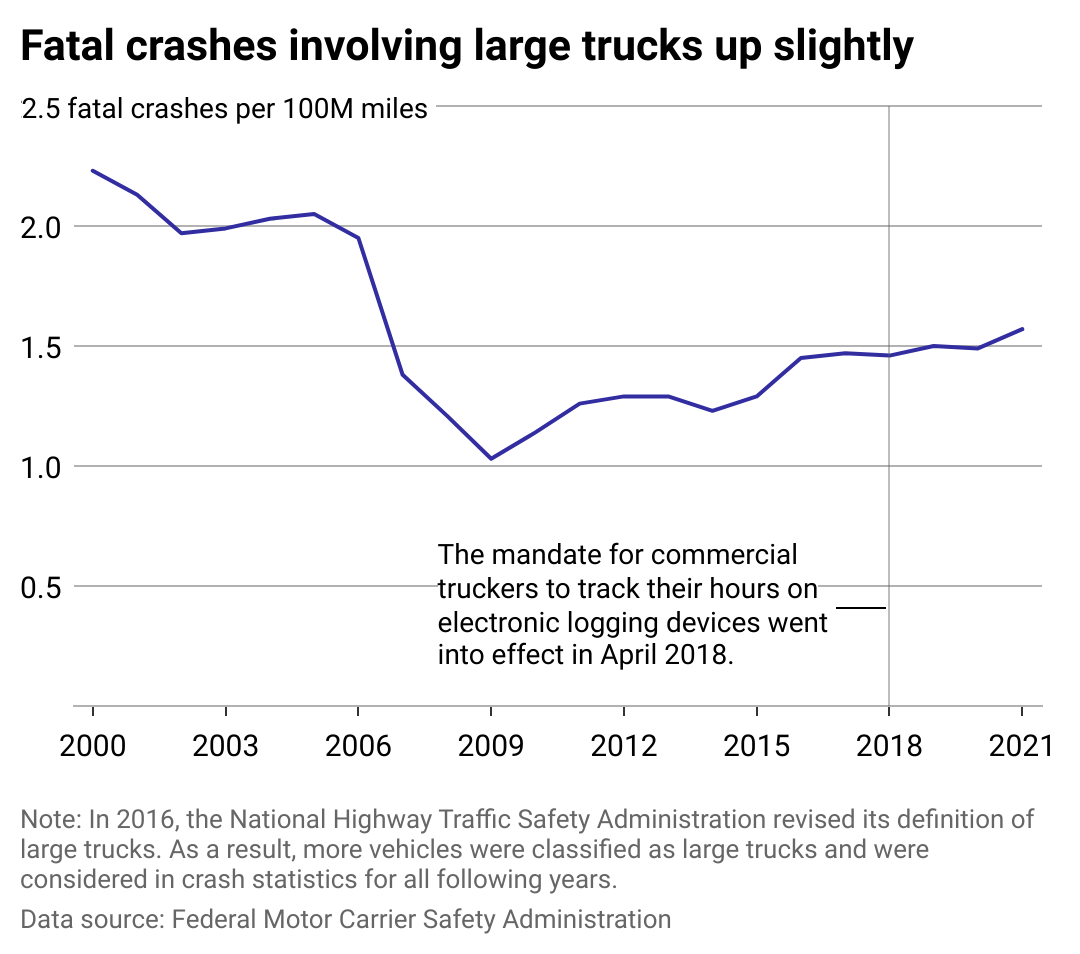Federal mandates meant to make trucking safer, so why have fatal truck accidents increased?

Canva
Federal mandates meant to make trucking safer, so why have fatal truck accidents increased?
A large blue truck on a rural road.
Semis, big-rigs, or tractor-trailers—whatever you call them—are ubiquitous on American roadways and are the most common means of transport for goods in the country.
But 18-wheelers can contribute to dangerous situations. Rushed drivers, cramped roadways, a lack of parking, and large blindspots lead to accidents and fatalities.
Federal Motor Carrier Safety Administration laws have been in place since the 1930s, and state truckers should not drive more than 11 hours in a 14-hour period. Legislators at the time reasoned that a well-rested driver was a safe driver. However, until 2018, drivers used paper logs they filled out by hand to track their hours. This practice allowed numerous drivers to fudge their records, Alex Scott, an assistant professor of supply chain management at the University of Tennessee, Knoxville, told FreightWaves.
Say a driver is only 30 minutes from home; they may decide to push on through the night despite being technically over the legal “hours of service.” In addition, some owner-operators face the decision of either obeying the law to the tee or delivering their goods late, which could create a cascading effect on the rest of the week’s delivery and jeopardize their client’s business, logistics industry reporter Rachel Premack explained in a FreightWaves interview.
In those cases, drivers simply jotted down hours permitted under the law to keep federal inspectors happy.
In 2018, federal mandates requiring commercial truckers to track their working hours on electronic logging devices in their cabs went into effect. The mandates aimed to reduce accidents and fatalities, and the auto-tracking ultimately meant drivers could no longer skirt the law.
However, enforcing ELDs may have backfired as fatalities have ticked up slightly since 2018.
To assess whether the ELD rule has had its intended impact, Truck Parking Club visualized data from the Federal Motor Carrier Safety Administration to see how rates of fatal truck accidents have changed since it went into effect. The analysis also examines other factors affecting truck safety and the inherent complications in measuring the success of individual policies.
![]()

Truck Parking Club
Truck-involved fatal crashes up slightly since ELD mandate
A line chart titled, fatal crashes involving large trucks upticks slightly, showing the rate of fatal crashes involving large trucks from 2000 to 2021.
Following the enforcement of ELDs on April 1, 2018, federal data shows a decrease in hours of service citations but an increase in accidents for solo drivers or carriers with up to six trucks. For larger companies with more trucks, citations for exceeding the hour limit remained roughly the same, but accidents initially spiked before rising and falling over the following months.
There are a few explanations for this disparity. According to a 2019 report in the S&P Global Market Intelligence Research Paper Series, larger companies were more likely to have implemented ELDs ahead of the mandate—and they had a chance to adapt to the new monitoring technology, while owner-operators and smaller carriers had a steeper learning curve.
Smaller companies also had more skin in the game. With fewer drivers to substitute when they reach a time limit, drivers for smaller companies may take a larger hit for a missed delivery. The ELDs force them to obey hour-of-service limitations. Drivers may, in turn, drive more dangerously by speeding or rapidly changing lanes to dodge traffic.
Remember, drivers are compensated per mile, not hours in the cab; a fast truck is a profitable truck.
“Workers may compensate for this lost income by driving more intensively, namely, covering more miles per hour,” according to the authors of the paper. “Unfortunately, this may also incentivize an increase in unsafe driving behavior, which is more tightly correlated to accident rates than hours of service violations.”
The researchers cited an increase in unsafe driving violations by owner-operators, which increased between 23% and 33%, and speeding violations, which increased between 23% and 31%, following the mandate.
Other aggravating factors include truck drivers not being paid overtime and going unpaid any time the truck isn’t moving toward its end goal, including during fuel and meal breaks, driving miles out of the way to look for parking, which is in scarce supply, and during the lengthy “detention” time when they are waiting to unload their goods.
Additionally, the industry faces a labor shortage, with high attrition among its ranks. According to the Department of Transportation, truck driver turnover rates exceed 90% for large, long-haul carriers and 72% for smaller carriers. That means many in the workforce are new to driving a semi-truck, and a 2020 study by Virginia Tech Transportation Institute shows that inexperienced drivers are more likely to be involved in an accident.
All these factors may have contributed to slightly more fatalities despite regulators’ best intentions.
Story editing by Mary Reardon. Additional editing by Kelly Glass. Copy editing by Kristen Wegrzyn.
This story originally appeared on Truck Parking Club and was produced and
distributed in partnership with Stacker Studio.
